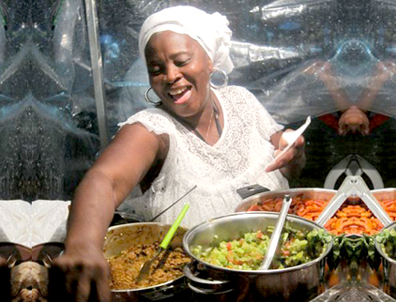
My trip has been like a crazy Saturday night: nonstop, intoxicating, and at times dangerous. I’ve been on a three month journey through South America, I danced through Rio like a Carioca, ate and drank myself to delirium in Buenos Aires, and felt the spray of nearly escaped disaster on the back of my neck as Chile’s beaches were crushed by an 8.8 earthquake. Salvador, Brazil is my Sunday morning and I’m worn out, still slightly high from the night before, and hungry. This is the last stop of my trip and I’m looking for food that brings me comfort, that’s easy, that’s gratifying. I’m putting down the guidebook and hoping that the food finds me.
As my friend totes me around the beaches and hillsides of the city, I notice that I won’t have to search far for the meal I want. Call it the tired traveler’s embrace of serendipity. I’m thirsty so I don’t look farther than the sugar cane cart outside of the church Igreja do Bonfim. It’s sweet and refreshing and perfect. I’m feeling like a snack and the shortest line at the street fair is the woman selling beans. They’re the best dang beans I’ve ever had on the beach. With the help of a friend, the rest of the trip continues like this. Here’s what it tasted like:
Acarajé: It wasn’t the pungent smell of frying palm tree oil that drew me in, but the Baiana’s bright white dress, the shine from her silver earrings, and the pots filled with mystery ingredients. The most traditional Bahian food is a black-eyed pea fritter stuffed with a variety of stews, dried shrimp, hot pepper sauce, and tomatoes. Served on the street, it’s rumored that the best can be found in Rio Vemelho.
Crab and beer: Looking for a quiet waterside bar to nurse a beer and listen to the sounds of the waves? Well it ain’t here. Caranguejo de Sergipe (http://www.caranguejodesergipe.com.br/) is humming with the pounding, cracking and sucking of crab shells, and the endless popping of Skol Cerveja bottles. Be prepared to work that plastic mallet, chug your beer, and flail your arms the best you can to flag down a waiter.
Moqueca: Even the name sounds delicious, muh-queh-caaah. A stew made with coconut milk and shrimp served bubbling in a clay pot. Accompanied by rice, farofa, and a squishy yellow gooey stuff that I’ve yet to figure out.
Brigadeiro: Life can’t get much sweeter than a chocolate ball filled with chocolate and condensed milk. Often found at children’s birthday parties, but since I wasn’t invited, we found them at A Cubana in Pelhourinho.
Rosti: Imagine a hash brown pie with shrimp, meat, cheese or veggies and you’ll get a Rosti. It’s a hearty meal and it went down well while sitting in Tudo Azul, a restaurant on the waterfront in Barra whose walls are filled with signatures and notes from visitors past. The owners are a Swiss-Brazilian couple who combine Italian, Brazilian and Swiss influences.
Caipiroska: While Roska means trash in Finnish, Caipiroska means the best vodka drink I ever had. These versions of caipirinhas are made with different fruits, but my favorite was acerola, a cherry-like fruit.
Ice cream: Green coconut. Guava cream. Passion Fruit. And many of the flavors at Sobeteria Da Ribeira, Salvador’s most popular ice cream parlor, don’t even translate to English. It was a race against the heat as my dessert dripped down my hands, by the time I looked up from my cone, the sun had set, the orange moon was out, and my trip to Salvador was complete.
